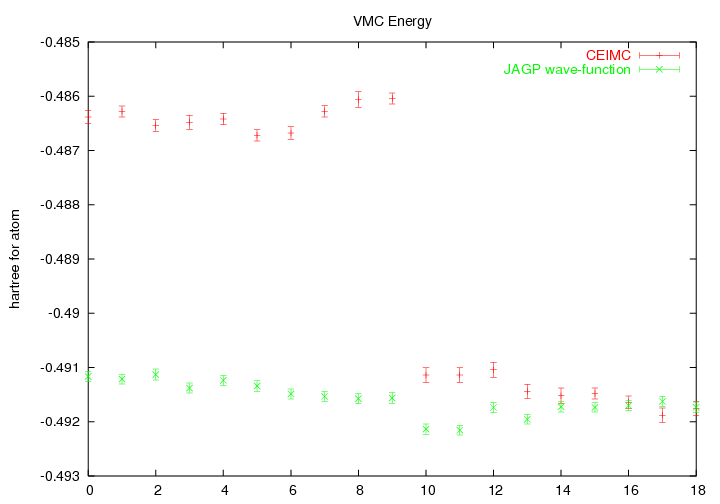|
|
|
|
|
|
|
-0.4742(2) | 0.0764(2) | -0.4857(1) |
|
|
-0.4857(2) | 0.0274(2) | -0.4900(1) |
|
|
-0.4870(10) | -0.4890(5) | |
|
|
-0.4871(5) | 0.0700(1) | -0.49019(5) |
|
|
-0.4846(2) | 0.067(1) | -0.4880(1) |
|
|
|
|
|
|
|
-0.4742(2) | 0.0764(2) | -0.4857(1) |
|
|
-0.4857(2) | 0.0274(2) | -0.4900(1) |
|
|
-0.4870(10) | -0.4890(5) | |
|
|
-0.4871(5) | 0.0700(1) | -0.49019(5) |
|
|
-0.4846(2) | 0.067(1) | -0.4880(1) |
Moreover we compare the energies and variances obtained on different configurations generated with the CEICM method (8). In the figure 6.1 the first ten configurations are obtained at ![]() . Then the system is cooled to
. Then the system is cooled to ![]() and it starts to clusterize. If we compare the wave-function of Holzmann et al. (8) with the JAGP wave-function we can see that the latter one gives an accurate description of both the liquid and the cluster phase. This is due to the resonating nature of the JAGP trial-function that allows to describe the liquid phase through resonating bonds among different atoms.
and it starts to clusterize. If we compare the wave-function of Holzmann et al. (8) with the JAGP wave-function we can see that the latter one gives an accurate description of both the liquid and the cluster phase. This is due to the resonating nature of the JAGP trial-function that allows to describe the liquid phase through resonating bonds among different atoms.

|

|
Then we compared the pressure obtained by using the GLQ technique, obtained after equilibration at given temperature and density, with both Gas-Gun experimental results 6.1 and numerical simulations done with CEICM method (7).
In the table 6.2 we report the pressures calculated for different densities and temperatures. The pressure was obtained as explained in section 4.3.
As it is shown the combination of GLQ with the JAGP wave-function provides a good agreement with the experimental values already with this small size.
6.2.